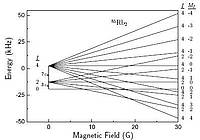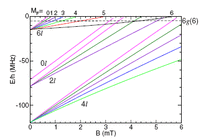 |
Hyperfine energy levels of alkali-metal dimers: ground-state homonuclear molecules in magnetic fields
Homonuclear alkali-dimer molecules are candidates for producing quantum gases of deeply bound molecules. Such gases can form if a large number of molecules are in the same state and if molecules are stable to collisions in the gas which requires an accurate knowledge of the hyperfine structure of low-energy levels of the system and its dependence on applied electric and magnetic fields. The density-functional theory calculations are applied in this article to calculate the nuclear hyperfine coupling constants for Li2, Na2, K2, Rb2 and Cs2 molecules. Zeeman splitting patterns have been investigated for two Rb2 isotope molecules in a three-step approach including rotational and electric quadrupole terms, scalar spin-spin interactions and finally spin-rotation and tensor spin-spin interaction terms. The results show that for rotationless molecules the zero-field splitting is determined by the scalar nuclear spin-spin coupling. By applying a magnetic field, each level splits into 2I+1 components but all the levels with a same value of MI remain parallel. This situation is different from the heteronuclear case and this may have important consequences for spectroscopic selection rules and for the collisional stability of molecules in excited hyperfine states.
The article appeared in the latest issue of Physical Review A, 79, 013401 (2009).
 |
Formation of Utracold LiCs molecules
Researchers at the University of Freiburg (now at the University of Heidelberg) report on the formation of ultracold LiCs molecules produced by the photoassociation technique starting from laser-cooled atoms confined in a magneto-optical trap. The molecular species are created via absorption of a photon from a laser source during an atomic collision. The product of such a reaction is a molecule in an excited state which then decays to form either a pair of atoms or a molecule in its ground energetic state. In this article, an ultracold gas of LiCs dipoles are produced for the first time in the vibrational and rotational ground state opening the way to a number of fundamental studies on dipolar gases, measurement of fundamental constants and investigation of ultracold chemical reactions.
The results have been selected as Editor's Choice in Physical Review Letter 101, 133004 (2008) and highlighted by Simon Cornish in Physics 1, 24 (2008).
 |
Computation of molecular dimers: bound states and hyperfine energy levels
Professor Hutson for the University of Durham in collaboration with the University of Maryland (US) has presented a computational method for ultracold alkali-metal bound states within the QuDipMol project. The calculations taking into account magnetic fields have been applied to the Cs2 molecule which is of great interest for ultra-low temperature experiments. The results have appeared in a recent issue of Physical Review A 78, 052703 (2008).
The group at Department of Chemistry at Durham University has also investigated heteronuclear alkali-metal dimers such as KRb and RbCs in order to reveal the hyperfine structure in the presence of electric and magnetic fields. Read more about these results in Physical Review A 78, 033434 (2008).

